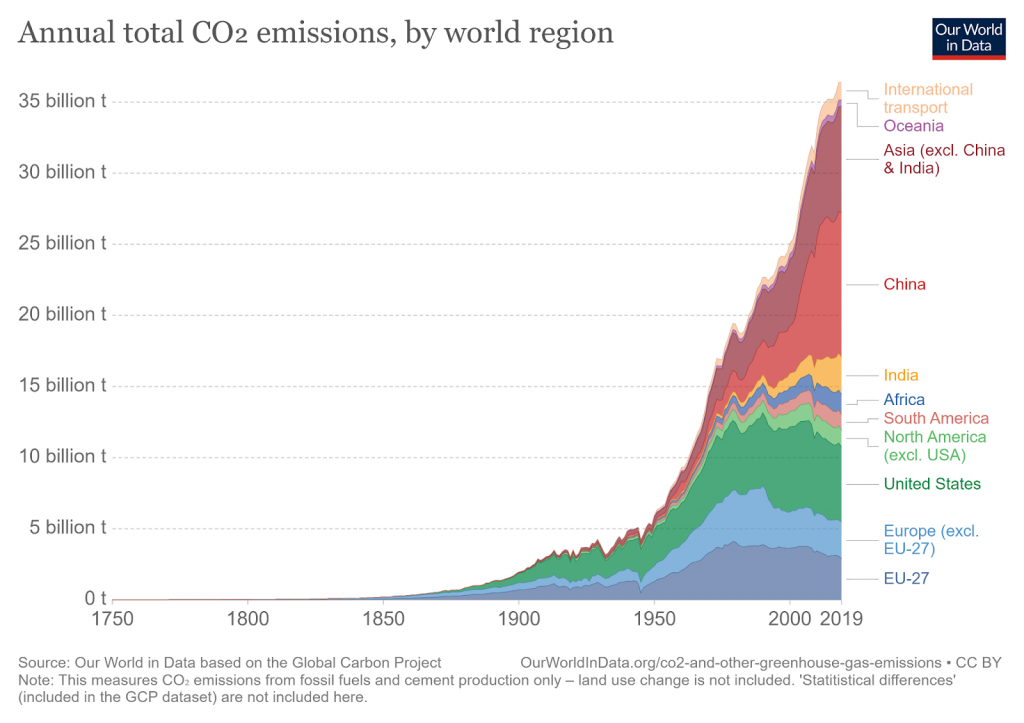Carbon Removal vs Carbon Capture: What’s the Difference?
Impactful Ninja is reader-supported. When you buy through links on our site, we may earn an affiliate commission.
Learn more
Learn more
.
Hey fellow impactful ninja ? You may have noticed that Impactful Ninja is all about providing helpful information to make a positive impact on the world and society. And that we love to link back to where we found all the information for each of our posts. Most of these links are informational-based for you to check out their primary sources with one click. But some of these links are so-called "affiliate links" to products that we recommend. First and foremost, because we believe that they add value to you. For example, when we wrote a post about the environmental impact of long showers, we came across an EPA recommendation to use WaterSense showerheads. So we linked to where you can find them. Or, for many of our posts, we also link to our favorite books on that topic so that you can get a much more holistic overview than one single blog post could provide. And when there is an affiliate program for these products, we sign up for it. For example, as Amazon Associates, we earn from qualifying purchases. First, and most importantly, we still only recommend products that we believe add value for you. When you buy something through one of our affiliate links, we may earn a small commission - but at no additional costs to you. And when you buy something through a link that is not an affiliate link, we won’t receive any commission but we’ll still be happy to have helped you. When we find products that we believe add value to you and the seller has an affiliate program, we sign up for it. When you buy something through one of our affiliate links, we may earn a small commission (at no extra costs to you). And at this point in time, all money is reinvested in sharing the most helpful content with you. This includes all operating costs for running this site and the content creation itself. You may have noticed by the way Impactful Ninja is operated that money is not the driving factor behind it. It is a passion project of mine and I love to share helpful information with you to make a positive impact on the world and society. However, it's a project in that I invest a lot of time and also quite some money. Eventually, my dream is to one day turn this passion project into my full-time job and provide even more helpful information. But that's still a long time to go. Stay impactful,Affiliate Disclosure
Why do we add these product links?
What do these affiliate links mean for you?
What do these affiliate links mean for us?
What does this mean for me personally?
![]()
Carbon removal and carbon capture are two methods of reducing global atmospheric carbon levels to mitigate global warming. And although they are often used in the same context, they are different methods of climate action with different mechanisms. So, we had to ask: What’s the difference between carbon removal and carbon capture?
Carbon removal is the elimination of carbon emissions after they have entered our atmosphere. Carbon capture is the trapping of carbon emissions just after they’ve been emitted but before they can enter our atmosphere.
In the fight against climate change, how can we tell the difference between carbon removal and carbon capture? Below we will define both terms, identify the key advantages and differences of each, explore how they operate and what impact they have on carbon emissions, and discuss why they are both important in the fight against climate change.
How Are Carbon Removal and Carbon Capture Defined
Carbon removal and carbon capture are two sustainability tools that can help individuals and organizations lower their carbon footprints. But since they are different mechanisms, understanding their differences is important.
What Does the Dictionary Say About Carbon Removal and Carbon Capture
Carbon removal, also referred to as negative emissions or carbon drawdown, is the process of eliminating carbon from the atmosphere.
“Carbon Removal: the process of removing CO2 from the atmosphere”
The Intergovernmental Panel on Climate Change
Different carbon removal processes can include:
- Afforestation/reforestation: Planting new forests
- Soil carbon sequestration: Storing captured carbon in the soil
- Biochar: Creating charcoal and burying it or plowing it into fields
- Bioenergy: Capturing and sequestering carbon from biofuels and bioenergy plants
- Enhanced mineralization: Crushed rocks are spread over the land to absorb carbon
- Direct Air Capture (DAC): Machines suck carbon out of the atmosphere and store it in geological formations underground
- Ocean-based Methods: Ocean alkalization/fertilization, artificial upwelling/dwelling
One of the most prominent examples of carbon removal is Climeworks, a DAC company founded in Zurich, Switzerland. Their specialized machines take CO2 from the air, mix it with water, and pump it deep underground. Through the process of natural mineralization, the captured CO2 is turned into stone. For every 100 tons of CO2 captured from the air, 90 tons are permanently removed, and only up to 10 tons are re-emitted by the DAC machines.
Carbon removal processes eliminate carbon after it is emitted and after it has already entered our atmosphere. But they aren’t the available tools. Carbon capture is another option to reduce carbon emissions.
“Carbon Capture: a way of collecting the carbon produced when fuel is burned, so that it is not released into the air”
Cambridge Dictionary
Carbon capture refers to the process of capturing carbon after it is emitted, but before it can enter our atmosphere. After it has been captured, carbon can either be stored deep underground or repurposed into commercially-marketable products. This is referred to as carbon capture and storage/sequestration (CCS).
There are 3 main types of carbon capture:
- Pre-combustion: Before fossil fuels are burned, the fuel is converted into a mix of hydrogen and CO2.
- Post-combustion: After fossil fuels are burned, the CO2 is removed from the resulting flue gas.
- Oxyfuel: Fossil fuels are burned in the presence of almost pure oxygen, resulting in CO2 and steam as byproducts.
As of 2020, there were a minimum of 26 carbon capture projects operating globally, with 21 more in early development and 13 in advanced development. Carbon capture has been demonstrated in industrial sectors such as coal gasification, ethanol production, fertilizer production, natural gas processing, refinery hydrogen production, and coal-fired power generation.
What Are the Differences Between and Advantages of Carbon Removal and Carbon Capture
Both carbon removal and carbon capture represent ways in which we can mitigate carbon emissions and global warming. But they are also different methods of climate action with different environmental impacts, making it important to understand their differences.
The main difference between carbon removal and carbon capture is that carbon removal removes the carbon that has already been emitted from our atmosphere. On the other hand, carbon capture targets the carbon that has already been emitted but has not yet entered our atmosphere.
The following are key advantages of carbon removal:
- Removes carbon from the atmosphere permanently
- Reduces atmospheric carbon dioxide levels
The following are key advantages of carbon capture:
- Removes carbon before it enters our atmosphere
- Can lead to either carbon storage or carbon repurposing
How Do Carbon Removal and Carbon Capture Impact Your Carbon Footprint
Knowing the similarities and differences between carbon removal and carbon capture is important when making a decision of which one to use.
| Carbon Removal | Carbon Capture | |
| How are carbon emissions reduced | Carbon removal represents indirect emission reductions. Carbon is eliminated after the emissions have already entered our atmosphere. | Carbon capture represents indirect emission reductions. Carbon is captured after combustion but before it is allowed to enter our atmosphere. |
| Impact on own carbon emissions | Carbon removal does not directly reduce your carbon footprint. | Carbon capture does not directly reduce your carbon footprint. |
| Impact on global carbon emissions | Carbon removal mitigates the problem, but it does not work at the core issue of reducing overall CO2 emissions. | Carbon capture mitigates the problem, but it does not work at the core issue of reducing overall CO2 emissions. |
| Environmental benefits | Carbon removal aids in climate change mitigation. | Carbon capture aids in climate change mitigation. |
| Overall effectiveness in reducing carbon emissions | Cost and storage capacity limits affect carbon removal effectiveness on a global scale. | High upfront costs and low economic incentives limit carbon capture effectiveness on a global scale. |
How Do Carbon Removal and Carbon Capture Reduce Carbon Emissions
The goal of both carbon removal and carbon capture is to reduce carbon emissions to mitigate climate change.
- Carbon removal: Carbon removal represents indirect emission reductions. Carbon is captured after emissions have already entered our atmosphere.
- Carbon capture: Carbon capture represents indirect emission reductions. Carbon is captured after combustion but before it is allowed to enter our atmosphere.
Carbon removal still permits the combustion of fossil fuels at current rates, it just removes the carbon after it has entered our atmosphere. The carbon is then stored permanently in land or ocean-based reservoirs.
Carbon capture also still permits the combustion of fossil fuels at current rates, it just traps the emitted carbon before it enters our atmosphere. It can then be stored or repurposed into other materials.
What Impact Do Carbon Removal and Carbon Capture Have on Your Own Carbon Emissions
One of the best ways we can aid in the fight against global climate change is to reduce our carbon footprint. And to do this we first have to reduce our carbon emissions.
- Carbon removal: Carbon removal does not directly reduce your carbon footprint.
- Carbon capture: Carbon capture does not directly reduce your carbon footprint.
Carbon removal and carbon capture do not directly reduce your own carbon emissions. They are both indirect methods of emission reduction, and knowing there is an option to essentially erase our emissions after we cause them negates any incentive of reducing emissions by our own accord.
What Impact Do Carbon Removal and Carbon Capture Have on Global Carbon Emissions
Every year we pump over 36 billion tons of CO2 into the atmosphere, fueling climate change. This causes temperature and sea-level rise, melting of sea ice, changing precipitation patterns, and ocean acidification. Carbon removal and carbon capture aim to reduce global emissions and mitigate these negative environmental effects.
- Carbon removal: Carbon removal mitigates the problem, but it does not work at the core issue of reducing overall CO2 emissions.
- Carbon capture: Carbon capture mitigates the problem, but it does not work at the core issue of reducing overall CO2 emissions.
Carbon removal does not have a significant impact on global carbon emissions. To contribute substantially in the fight against climate change, global carbon removal capacity would need to reach 10 gigatons (Gt) of carbon by 2050 and 20 Gt of carbon for each year from 2050-2100. Currently, carbon removal processes contribute negligibly to this amount.
Carbon capture does not have a significant impact on global carbon emissions. Once it has been captured, the most common next step is to store the carbon. In 2021, overall carbon capture and storage installed capacity reached 40 million tonnes per annum. But in order for CCS to contribute substantially in the fight against climate change, installed capacity must reach 5,600 million tonnes per annum.
Thus there still remains a substantial gap between what we currently have and what is needed to reduce our emissions to Paris Climate Agreement target levels for both carbon removal and carbon capture.
The COVID-19 pandemic triggered the largest decrease in energy-related carbon emissions since World War II, a decrease of 2 billion tonnes. However, emissions rebounded quickly and rose by 6% in 2021 to 36.3 billion tonnes, their highest ever level. This indicates that the earth is still warming at an accelerated rate, and not enough is being done to implement clean energy practices.

What Are the Environmental Benefits of Carbon Removal and Carbon Capture
Using carbon removal and carbon capture can reduce our consumption of and reliance on fossil fuels (i.e., coal, oil, and natural gas) which can reduce the effects of global warming by limiting global greenhouse gas emissions. But they also come with various environmental benefits.
- Carbon removal: Carbon removal aids in climate change mitigation.
- Carbon capture: Carbon capture aids in climate change mitigation.
Carbon removal and carbon capture aid in climate change mitigation because they both aim to reduce the amount of carbon emissions entering our atmosphere. Levels of carbon emissions increased exponentially to more than 35 billion tons per year at the end of the 20th century. And the global average amount of carbon in the atmosphere today registers at over 400 parts per million.
The more carbon there is in our atmosphere, the more serious climate change becomes. When carbon and other air pollutants absorb sunlight and solar radiation in the atmosphere, they trap the heat and act as an insulator for the planet. Since the Industrial Revolution, Earth’s temperature has risen a little more than 1 degree Celsius (C), or 2 degrees Fahrenheit (F). But this rate has more than doubled since 1981, with a current global annual temperature rise of 0.18C, or 0.32F, for every 10 years.
Rising global temperatures can wreak havoc on our environment. So the more we remove or capture carbon emissions, the more we slow the rates of sea-level rise, ice melting, extreme weather occurrences, and ocean acidification. When these rates are slowed, the earth’s biodiversity does not have to struggle to adapt to temperature and pH changes. People will not be displaced due to the flooding of coastal areas. And icebergs will continue to provide climate regulation.
How Effective Are Carbon Removal and Carbon Capture in Reducing Carbon Emissions
Carbon removal and carbon capture can be effective at reducing carbon emissions under certain conditions. Both are reactive, rather than proactive, methods of dealing with carbon emissions which limits their overall effectiveness.
- Carbon removal: Cost and storage capacity limits affect carbon removal effectiveness on a global scale.
- Carbon capture: High upfront costs and low economic incentives limit carbon capture effectiveness on a global scale.
The main factors affecting carbon removal effectiveness are the cost and storage capacity limits, which are dependent on the method of removal that is used. For example, planting trees is one of the cheapest and most natural ways to remove carbon from the atmosphere, but the storage capacity is limited by available land and can be negatively impacted by deforestation. On the other hand, direct air capture is more expensive than planting trees ($250-$650 per 1,000kg compared to $50 per 1,000kg), but the storage capacity is vastly greater.
Carbon removal and carbon capture are reactive, rather than proactive, ways of dealing with emissions. In this manner, we can continue to use fossil fuels at an accelerated rate. They are also expensive to implement, and there will be little economic incentive to use them until the cost of emitting carbon rises enough to prompt behavioral changes.
Why Are Both Carbon Removal and Carbon Capture Important to Fight Climate Change
Carbon removal and carbon capture are important to fight climate change because they are both ways to reduce carbon emissions. This mitigates the effects of climate change, which has a positive cascade effect on public health and plant and animal diversity. In addition, it boosts the global economy and leads to innovative, more environmentally-friendly solutions.
However, carbon removal and carbon capture should not be used as a panacea for climate change. Relying on carbon removal and carbon capture solely is impractical because they are reactive (indirect) rather than proactive (direct) ways of dealing with emissions.
In the long term, direct methods of carbon footprint reduction are much more effective. Reducing your household, travel, and lifestyle carbon footprint can go a long way in the fight against climate change!
What are Better Alternatives to Carbon Removal and Carbon Capture
If used correctly, carbon removal and carbon capture can provide environmental, economic, and social benefits that go beyond reducing carbon emissions. They have the potential to instigate meaningful environmental change and begin to reverse some of the effects of climate change.
However, we can’t let these two methods be a guilt-free way to reduce carbon emissions. Carbon removal and carbon capture must be used in conjunction with carbon reduction measures until the industry has time to invest, develop, and refine more sustainable innovations.
These reduction measures don’t have to involve drastic changes either. Actions that may seem small can have a big impact because those small changes add up! You can reduce your carbon footprint in three main areas of your life: household, travel, and lifestyle.
Reduce your household footprint:
- Wash with cold water: Washing clothes in cold water could reduce carbon emissions by up to 11 million tons. Approximately 90% of the energy is used to heat the water, so switching to cold saves also saves energy.
- Replace incandescent bulbs with fluorescent bulbs: Fluorescent bulbs use 75% less energy than incandescent ones, saving energy and thus reducing electricity demand and greenhouse gas emissions.
Reduce your travel footprint:
- Fly less: Aviation accounts for around 1.9% of global carbon emissions and 2.5% of CO2. Air crafts run on jet gasoline, which is converted to CO2 when burned.
- Walk or bike when possible: The most efficient ways of traveling are walking, bicycling, or taking the train. Using a bike instead of a car can reduce carbon emissions by 75%. These forms of transportation also provide lower levels of air pollution.
Reduce your lifestyle footprint:
- Switch to Renewable Energy Sources: The six most common types of renewable energy are solar, wind, hydro, tidal, geothermal, and biomass energy. They are a substitute for fossil fuels that can reduce the effects of global warming by limiting global carbon emissions and other pollutants.
- Recycle: Recycling uses less energy and deposits less waste in landfills. Less manufacturing and transportation energy costs means less carbon emissions generated. Less waste in landfills means less CH4 is generated.
- Switch from single-use to sustainable products: Reusing products avoids resource extraction, reduces energy use, reduces waste generation, and can prevent littering.
- Eat less meat and dairy: Meat and dairy account for 14.5% of global greenhouse gas emissions, with beef and lamb being the most carbon-intensive. Globally, we consume much more meat than is considered sustainable, and switching to a vegan or vegetarian diet could reduce emissions.
- Take shorter showers: Approximately 1.2 trillion gallons of water are used each year in the United States just for showering purposes, and showering takes up about 17% of residential water usage. The amount of water consumed and the energy cost of that consumption are directly related. The less water we use the less energy we use. And the less energy we use, the less of a negative impact we have on the environment.
Final Thoughts
In short, carbon removal is not the same thing as carbon capture. Carbon removal occurs after the emitted carbon has already entered our atmosphere. Carbon capture is the trapping of carbon emissions after they have been emitted but before they enter our atmosphere.
Both are tools in our sustainability toolbox that can be used to reduce carbon emissions and mitigate climate change. But we should not rely on either or both to be a cure-all for our environmental problems. Direct measures of carbon emission reduction are much more effective in reducing emissions both in the short term and in the long term.
Stay impactful,

Sources
- American University: What is Carbon Removal?
- Climeworks: Homepage
- Climeworks: Direct air capture to help reverse climate change
- The London School of Economics and Political Science: What is carbon capture and storage and what role can it play in tackling climate change?
- Britannica: Flue Gas Treatment
- Center for Climate and Energy Solutions: Carbon Capture
- Our World in Data: CO2 emissions
- National Wildlife Federation: Climate Change
- World Resources Institute: Carbon Removal
- Global CCS Institute: Global Status of CCS 2021
- US Department of Energy – Office of Fossil Energy and Carbon Management: Carbon Dioxide Removal FAQs
- International Energy Agency: After steep drop in early 2020, global carbon dioxide emissions have rebounded strongly
- International Energy Agency: Global CO2 emissions rebounded to their highest level in history in 2021
- Impactful Ninja: What Is the Carbon Footprint of Coal Energy? A Life-Cycle Assessment
- Impactful Ninja: What Is the Carbon Footprint of Oil Energy? A Life-Cycle Assessment
- Impactful Ninja: What Is the Carbon Footprint of Natural Gas? A Life-Cycle Assessment
- National Oceanic and Atmospheric Administration: Climate Change – Atmospheric Carbon Dioxide
- National Resources Defense Council: Global Warming 101
- World Economic Forum: Carbon removal – the Three Conditions to Make it Successful
- CNBC: Carbon capture technology has been around for decades — here’s why it hasn’t taken off
- World Resources Institute: Direct Air Capture – 3 Things to Know
- The Ocean Foundation: Reduce Your Carbon Footprint
- Cold Water Saves: Washing Laundry In Cold Water Protects A Lot More Than Just Our Clothing.
- Energy Information Administration: Renewable Energy Explained
- Energy Star: Compact Fluorescent Light Bulbs (CFLs) and Mercury
- Our World in Data: Where in the world do people have the highest CO2 emissions from flying?
- Our World in Data: Which form of transport has the smallest carbon footprint?
- Zero Waste Europe: Reusable vs Single Use Packaging
- Carbonbrief: Interactive – What is the climate impact of eating meat and dairy?
- Stop Waste: Recycling and Climate Protection
- Impactful Ninja: Is Taking Long Showers Bad for the Environment?
- United States Environmental Protection Agency: Showerheads




